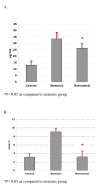Resveratrol inhibits nonalcoholic fatty liver disease in rats
- PMID: 18782455
- PMCID: PMC2547101
- DOI: 10.1186/1471-230X-8-40
Resveratrol inhibits nonalcoholic fatty liver disease in rats
Abstract
Background: The prevalence of nonalcoholic fatty liver disease (NAFLD) is high. NAFLD is linked to obesity, diabetes mellitus, and hypertriglyceridemia. Approximately 20% of patients with NAFLD will eventually develop cirrhosis. Our purpose was to investigate whether resveratrol decreased hepatic steatosis in an animal model of steatosis, and whether this therapeutic approach resulted in a decrease in tumor necrosis factor alpha (TNF-alpha) production, lipid peroxidation and oxidative stress.
Methods: Male Wistar CRL: Wi (Han) (225 g) rats were randomized into three groups. A control group (n = 12) was given free access to regular dry rat chow for 4 weeks. The steatosis (n = 12) and resveratrol (n = 12) groups were given free access to feed (a high carbohydrate-fat free modified diet) and water 4 days per week, and fasted for the remaining 3 days for 4 weeks. Rats in the resveratrol group were given resveratrol 10 mg daily by the oral route. All rats were killed at 4 weeks and assessed for fatty infiltration and bacterial translocation. Levels of TNF-alpha in serum, hepatic malondialdehyde (MDA), oxidative stress (superoxide dismutase, glutathione peroxidase, catalase and nitric oxide synthase) and biochemical parameters were measured.
Results: Fat deposition was decreased in the resveratrol group as compared to the steatosis group (Grade 1 vs Grade 3, P < 0.05). TNF-alpha and MDA levels were significantly increased in the steatosis group (TNF-alpha; 33.4 +/- 5.2 vs 26.24 +/- 3.47 pg/ml and MDA; 9.08 +/- 0.8 vs 3.17 +/- 1.45 muM respectively, P < 0.05). This was accompanied by increased superoxide dismutase, glutathione peroxidase and catalase and decreased nitric oxide synthase in the liver of resveratrol group significantly (P < 0.05 vs steatosis group). Bacterial translocation was not found in any of the groups. Glucose levels were decreased in the group of rats given resveratrol (P < 0.05).
Conclusion: Resveratrol decreased NAFLD severity in rats. This effect was mediated, at least in part, by TNF-alpha inhibition and antioxidant activities.
Figures



Similar articles
-
Voluntary oral feeding of rats not requiring a very high fat diet is a clinically relevant animal model of non-alcoholic fatty liver disease (NAFLD).Histol Histopathol. 2009 Sep;24(9):1161-9. doi: 10.14670/HH-24.1161. Histol Histopathol. 2009. PMID: 19609863
-
Resveratrol attenuates oxidative stress and prevents steatosis and hypertension in obese rats programmed by early weaning.J Nutr Biochem. 2013 Jun;24(6):960-6. doi: 10.1016/j.jnutbio.2012.06.019. Epub 2012 Sep 5. J Nutr Biochem. 2013. PMID: 22959054
-
Resveratrol, a red wine polyphenol, attenuates ethanol-induced oxidative stress in rat liver.Life Sci. 2007 Feb 20;80(11):1033-9. doi: 10.1016/j.lfs.2006.11.044. Epub 2006 Dec 15. Life Sci. 2007. PMID: 17258234
-
Hepatoprotective and therapeutic effects of resveratrol: A focus on anti-inflammatory and antioxidative activities.Fundam Clin Pharmacol. 2022 Jun;36(3):468-485. doi: 10.1111/fcp.12746. Epub 2022 Jan 17. Fundam Clin Pharmacol. 2022. PMID: 34935193 Review.
-
Antioxidant dietary approach in treatment of fatty liver: New insights and updates.World J Gastroenterol. 2017 Jun 21;23(23):4146-4157. doi: 10.3748/wjg.v23.i23.4146. World J Gastroenterol. 2017. PMID: 28694655 Free PMC article. Review.
Cited by
-
4Ps medicine of the fatty liver: the research model of predictive, preventive, personalized and participatory medicine-recommendations for facing obesity, fatty liver and fibrosis epidemics.EPMA J. 2014 Dec 7;5(1):21. doi: 10.1186/1878-5085-5-21. eCollection 2014. EPMA J. 2014. PMID: 25937854 Free PMC article. Review.
-
Protective effects of total glucosides of paeony and the underlying mechanisms in carbon tetrachloride-induced experimental liver injury.Arch Med Sci. 2011 Aug;7(4):604-12. doi: 10.5114/aoms.2011.24129. Epub 2011 Sep 2. Arch Med Sci. 2011. PMID: 22291795 Free PMC article.
-
Maslinic acid protects against obesity-induced nonalcoholic fatty liver disease in mice through regulation of the Sirt1/AMPK signaling pathway.FASEB J. 2019 Nov;33(11):11791-11803. doi: 10.1096/fj.201900413RRR. Epub 2019 Jul 30. FASEB J. 2019. PMID: 31361524 Free PMC article.
-
The Fluid Aspect of the Mediterranean Diet in the Prevention and Management of Cardiovascular Disease and Diabetes: The Role of Polyphenol Content in Moderate Consumption of Wine and Olive Oil.Nutrients. 2019 Nov 19;11(11):2833. doi: 10.3390/nu11112833. Nutrients. 2019. PMID: 31752333 Free PMC article. Review.
-
Biochemical determination of lipid content in hepatic steatosis by the Soxtec method.World J Gastroenterol. 2010 Mar 28;16(12):1495-9. doi: 10.3748/wjg.v16.i12.1495. World J Gastroenterol. 2010. PMID: 20333790 Free PMC article.
References
-
- Sheth SG, Gordon FD, Chopra S. Nonalcoholic steatohepatitis. Ann Intern Med. 1997;126:137–45. - PubMed
Publication types
MeSH terms
Substances
LinkOut - more resources
Full Text Sources
Medical

